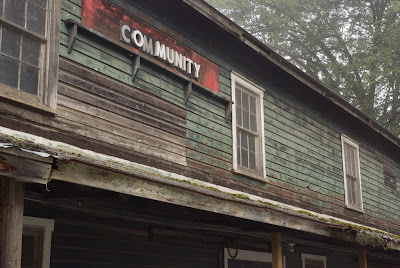
After the Steep Rock picnic Jane was marching in Southbury. She was worried that thunder showers might dampen her piping mood, and I was hoping an El Greco sky would make my photos moody. She headed south to her parade; I headed west toward whatever the much anticipated front was to bring. As I reached Wassaic the sky showed change was imminent, but not what change it would be. Wassaic was quiet. It was a stillness worthy of the old west, and I half expected tumbleweed to come rolling down the street in front of the grain elevator. Things still simmered in Wassaic over M's rightful place on the grain warehouse wall, but like L, most remained diplomatically silent. I chose to drive on without a shot.
Wassaic is interesting for lots of reasons. It is a tiny pocket surrounded by steep hills; the name of the town comes from a Native American word meaning "hard to access." It was the home of the first Borden's Milk plant, the place where the first condensed milk was perfected and made for delivery to troops in the Civil War (You can learn more at Wikopedia or http://hvrt.org/sect1full.html.). The survival of the train line, if only as commuter service, helps make the past palpable here. The factory still exists just across the track from the grain warehouse and near the grain elevator. In fact there's still much that exists in the surrounding hills to suggest the old network of dairy farming that lingers now at only a few isolated farms.
Around Wassaic the land in Amenia and beyond stretches out in broad valleys that frequently open grand panoramas. Just 8 miles east, in CT, as one approaches the Housatonic, the ridges get steep everywhere and the valleys are more confined. The further north one goes, the more pronounced the difference, and then you reach the Berkshires. Around Wassaic these broad valleys provided room for many farms to support large herds. To house such large herds the farmers here built huge barns with Dutch roofs to permit massive hay storage. Beneath these gothic hay lofts cows lined up, side-by-side, to feed. Often barns were wide enough to hold 4 or 6 such rows and long enough so one could never see the other end.
Once in easy reach of New York City by rail, today Amenia lies beyond all of the highways. The exception is the Taconic Parkway, but it is a hilly ride west, closer to the Hudson River. From the end of I-684 one must follow rickety old route 22 to reach Amenia. As a result, things have changed much more slowly in Amenia than any place to the south, east or west.
So these dinosaur barns linger on, a few as working farms, some as colossal wrecks, and many as lonely silos, tomb stones to mark the foundations where once a dairy industry thrived. The barn in the photo (You are seeing about a quarter of its total length, and it is supplemented by other, large out-buildings already caving in.) has been idle for years and may be torn down this fall. When it goes vast fields now burgeoning with corn and surrounding it for many miles will be seeded with rows of identical houses, each with its mail box and street light. What a panorama that will be!
They tore out the rail line above Wassaic many years back. It's now a lovely bicycle and hiking path, but train service will never return. In 2000 they restored commuter service to the end of the old track and built a new station on route 22 in Wassaic. That makes Amenia a sort of last frontier in the onward march of suburbia. In the meantime, it is fertile ground for photography, so my time is limited for shooting gothic barns beneath flashes of lightening and Toledo clouds.
As I walked around this barn a thunder shower dumped enough water to send me back to my car. The moody, lowering clouds I sought would have dictated a very different shot than the one I took. However, it is the colors here that make me like this picture of a bush. The real rumblings were to come a bit later and I was elsewhere.























